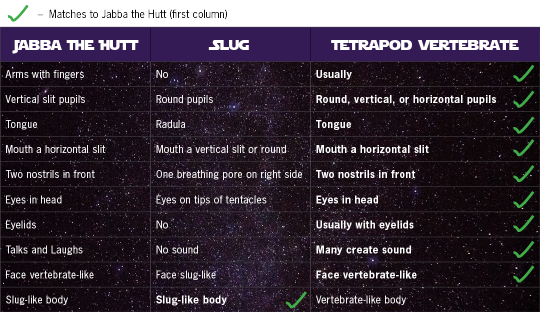
The movie Star Wars introduced us to Jabba the Hutt, with a slug-like body form. In the movie, he was an unsavory character and notorious Crime Lord with a fondness for Princess Leia.
Was Jabba the Hutt a real slug, or did he just look like one? In biology, we know that creatures can look similar either by descent or convergence. Two individuals that look similar by descent implies that their past common ancestor also looked similar. An example of similarity by descent is crows and canaries, that fly and look similar because their common ancestor could fly and looked similar. On the other hand, two individuals that look similar by convergence implies that their past common ancestor looked different, but they acquired their similar features independently. An example of similarity by convergence is birds and bats, that both fly and have wings, but their common ancestor did not fly or have wings.
It is easy to notice that Jabba the Hutt has a body shape like a slug, but I also noticed that he has features of other groups of creatures, for example, he has arms with fingers, as many tetrapod vertebrate animals have.

To evaluate whether Jabba the Hutt is slug-like because he is a real slug by descent or due to convergence, let’s compare Jabba the Hutt’s features with those of slugs and tetrapod vertebrates.
Table comparing 10 features of Jabba the Hutt to those of slugs and Tetrapoda

The table shows that Jabba the Hutt’s features match those of Tetrapoda in 9 out of 10 features (checked off in the table), suggesting he belongs to Tetrapoda vertebrates.
I conclude that Jabba the Hutt was not a slug.
I note that one can find suggestions on the internet that Jabba the Hutt had a skeleton, which is further support for my conclusion that he was not a slug.
Finally, I want to note that slugs can be very nice creatures. Comparing the villainous Jabba to a slug is disrespectful to slugs.
Timothy A. Pearce, PhD, is the head of the mollusks section at Carnegie Museum of Natural History. Museum employees are encouraged to blog about their unique experiences and knowledge gained from working at the museum.
